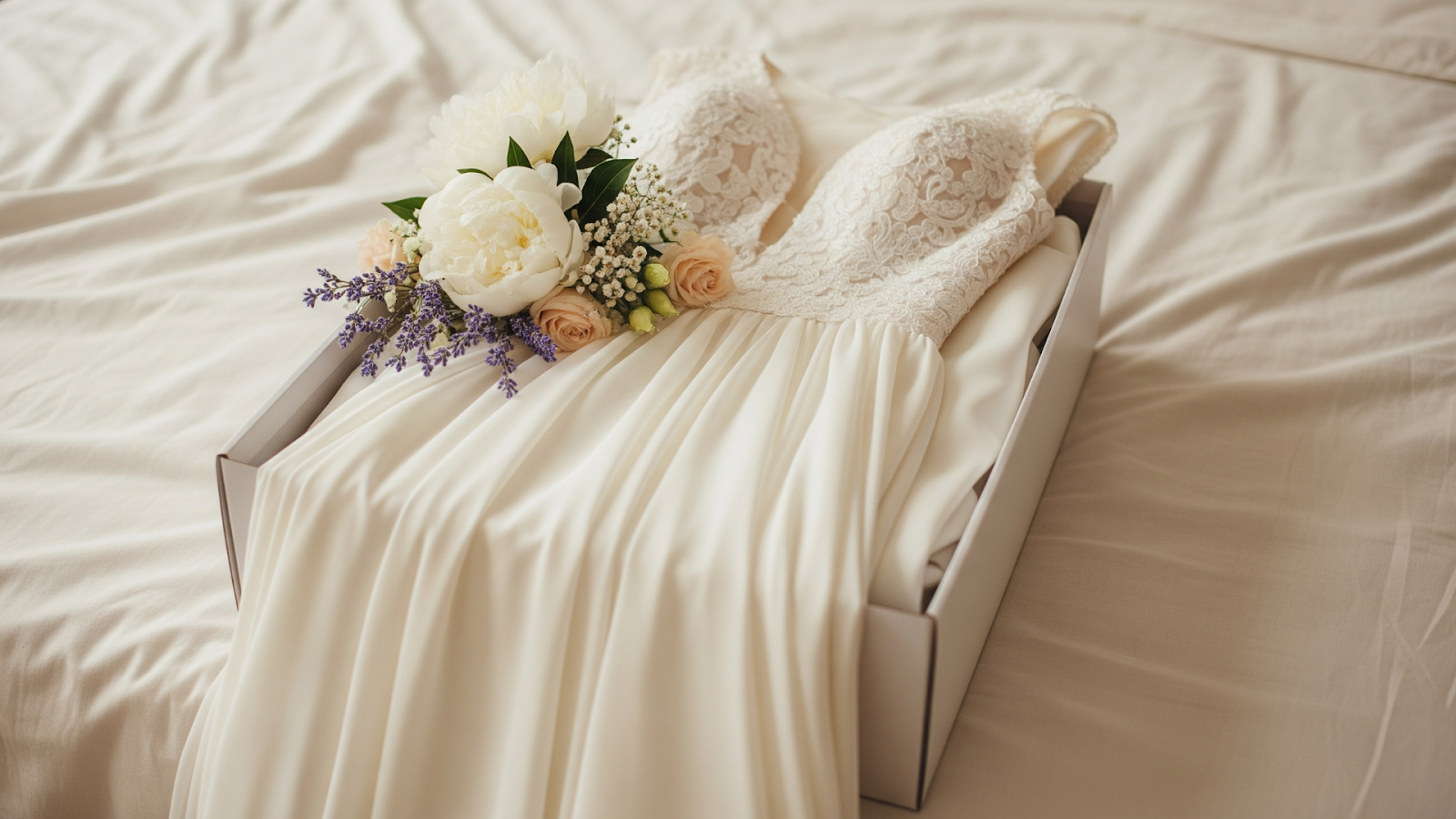SUMMARY:
-
Even if you store a wedding dress perfectly cleaned, the surrounding temperature, like humidity, cold, and more, can slowly damage it.
-
In damp climates, trapped moisture in sealed bags or boxes can lead to mold, mildew, yellowing, persistent musty odors, and reappearance of old stains hidden in the fibers.
-
Low-humidity climates strip the natural moisture from fibers, making fabrics stiff, prone to breakage, fraying, and cracking in embroidered or lace areas.
-
Beads, sequins, and zippers may corrode in environments with fluctuating temperatures and condensation, compromising both appearance and structure.
Many brides dream of keeping their wedding dress in perfect condition, whether they decide to treasure it as a keepsake or pass it down to future generations.
Some even imagine their gown walking down the aisle multiple times in the family’s history, just like the one in that Quora story that’s been worn by 11 brides!
To save on the often high wedding dress preservation cost, many choose the DIY options to store the gown themselves at home.
At first, it seems like the perfect solution, but after a few years or maybe even in just a few months, you decide to open the box, and you see yellow patches, and there is a musty odor coming from the fabric.
The surprising cause? It’s not always a cleaning mistake. The real culprit is the climate. The humidity, dryness, cold, heat, or even the sunlight damages the entire fabric.
To understand in detail how different climates impact the preservation of your DIY preserved wedding dress, read below!
How Do Different Climates Affect The DIY Preserved Wedding Dress?
A. Humid Climates - Mold, Mildew & Musty Odors
Storing your DIY cleaned wedding dress in a humid environment is one of the fastest ways to ruin all your hard work. Let’s understand what exactly happens.
1. Moisture Gets Trapped Without Proper Ventilation
When you place your dress in a storage box, plastic container, or a garment bag without any ventilation, the moisture from the surrounding areas gets trapped inside them.
And, if your bag is kept in a basement, attic, laundry room, or any tightly packed closet, the environment becomes even riskier. This is because these spaces tend to have poor airflow, and temperature fluctuations cause condensation.
As a result, the trapped moisture seeps into the fabric over weeks or months, which creates issues like stains, odors, and further deterioration.
2. Stains that Reappear or Spread Over Time
After doing your DIY cleaning job, you might think that every stain on your dress has been removed. But even if tiny, invisible particles of sweat, oil, or spilled beverages remain in the fibers, damp air can reactivate them.
And in some cases, these stains can spread further into the surrounding material.
3. A Breeding Ground for Mold and Mildew
Without ventilation, mold and mildew can grow on the fabric of the gown, especially in delicate areas such as the hem, train, or embroidery sections.
Once the mold begins, you will notice small black or brown dots on the fabric. Alongside the visual damage, mildew leaves a musty smell, which is extremely challenging to get rid of.
4. Yellowing, Fading, and Fabric Dullness
Humidity isn’t just about mold; it also speeds up the chemical reactions that cause fabric discoloration.
As a result, the gown loses its sparkle, especially if they are made of white, ivory, or champagne colors.
5. Weakening and Fraying of Delicate Fibers
With prolonged exposure to the environment, fabrics like silk, lace, organza, and satin absorb the water molecules from the air, which causes them to swell slightly.
This means you may eventually find frayed hems, tiny fabric shreds from lace, and satin that has lost its smoothness and glossy finish.
6. Persistent Odors and Lasting Damage
When fungi and bacteria proliferate within the fibers of the fabric, they release byproducts that cause the musty odor. And the problem is, even after multiple DIY solutions, this smell doesn’t go away easily.
This eventually makes the wedding gown unsuitable for future use or passing on as a family heirloom.
B. Dry Climates – Fabric Damage
While high humidity damages the gown, extremely dry climates present a completely different set of risks. Now, let’s understand how lack of moisture makes the fabric prone to breakage.
1. Lack of Moisture Weakens Delicate Fabrics
In overly dry environments, fibers lose their natural elasticity and become fragile. As a result, the gown tends to lose its graceful drape and texture.
2. Cracking or Fraying of Lace and Embroidery
Lace and embroidery are among the most delicate elements of any wedding gown. In a dry climate, the lack of humidity pulls the natural moisture out of these fabrics, and as a result, they become brittle.
Over time, this brittleness causes the visible cracking on the edges of the embroidered motifs.
And the worst part? Repairs are not as simple as sewing them back into place. They might require the replacement, which alters the original design and patterns of the dress.
3. Dust Accumulation and Surface Degradation
Dry climates also tend to have more airborne dust, which easily settles on fabrics. This is more specific if the dress is stored in an uncovered or loosely packed space.
As a result, the sheen of the fabric becomes dull, and if left unchecked, the dress can develop a rough or aged appearance.
C. Cold Climates – Hidden Risks from Unheated Storage
Cold climates can also cause serious and irreversible damage to the wedding outfit. Here’s how:
1. Freezing Temperatures Make Fabrics Stiff and Brittle
When the fabrics of the wedding dresses are exposed to very low temperatures for an extended period, the natural moisture within the fibers diminishes. This lack of internal moisture causes them to stiffen.
Once the cloth becomes rigid, it loses its flexibility and is more likely to snap or crack even under light handling. This is more common for gowns with intricate folds, pleats, or fitted bodices.
2. The Risk of Condensation
The danger isn’t over when the winter ends. As the temperature rises, especially in early spring, the unheated storage spaces like attics, garages, and basements experience sudden shifts from cold to warm.
This change often causes condensation, which means small water droplets form inside the storage boxes, bags, or directly on the dress. This moisture is absorbed quickly into the delicate fabrics, which leads to the growth of mold, mildew, and water stains.
D. Fluctuating Climates - Condensation & Fabric Distortion
Temperature changes cause the wedding dress fibers to repeatedly expand or contract. Here’s how it affects the material of the dress:
1. Expansion and Contraction of Fibers
As the temperature rises and falls, the delicate fibers of your gown physically expand and contract. This constant movement weakens the structural integrity of the fabric, which eventually causes it to stretch, warp, or even tear.
This repeated friction triggers the fabric aging process, leading to brittleness and loss of shape.
2. Rusting on Metal Embellishments
Storing the dress in spaces prone to temperature fluctuations creates a prime environment for condensation.
When warmer air meets the cold surface of the fabric or storage container, water vapor condenses into tiny droplets on the gown. This trapped moisture results in the rusting of the metal embellishments like beads, sequins, or zippers.
3. Weakening of the Threads
The changing temperature shrinks the thread holding the embellishments, resulting in loosening or even the loss of these pieces.
This deterioration affects the overall appearance of your gown.
4. Effect of Light Exposure on Fabric Color
Besides the temperature and moisture issues, the fluctuating environments in the attics and garages may expose your dress to sunlight or unfiltered artificial lights.
The UV rays and harsh indoor lighting can cause fading and uneven discoloration, which further damages the beauty of the dress.
Best Solution? Go for Professional Preservation!
When it comes to protecting your wedding dress for decades to come, nothing beats professional preservation. Their moisture-blocking yet breathable preservation kits ensure that the fabrics stay pristine and free from mold, mildew, and yellowing.
That’s why you should contact DressPreservation.com today. We’re proud to be a top-tier service provider of premium preservation kits that offer museum-quality care, expert support, and guaranteed results.
Also, we use SYSTEMK4 cleaning technology that removes every stain from the dress while protecting it against any future discoloration.
So, without a wait, preserve your gown with the care it deserves, and contact us today!
Quick Answers Brides Are Googling Regarding Wedding Dress Preservation
Can you wear a wedding dress after it's been preserved?
Yes, you can wear a wedding dress on various occasions after it’s been preserved. But it may nullify the benefits of the original preservation process.
Can I preserve my wedding dress 10 years later?
Yes, you can preserve your wedding dress 10 years later. But make sure that you get it done by a reputable preservation company like DressPreservation.com that offers preservation for wedding dresses up to 20 years. In case your gown is older than 20 years, then your gown might require restoration.
Can a yellowed wedding dress be restored?
Yes, a yellowed wedding dress can easily be restored if you get it done by a professional preservation and restoration company like DressPreservation.com
Where to store a wedding dress after preservation?
After preservation, store your wedding dress in a temperature-controlled area, away from attics and basements.
Is it worth preserving a wedding dress?
Yes, if you want to keep your dress in pristine condition for years to come and pass it on to future generations, it is worth preserving a wedding dress.








